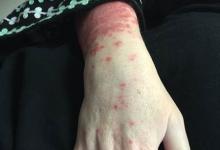Hot Stuff Part III: Zoster and Biologics: Special Considerations Save
Dr. Leonard Calabrese - Zoster and Biologics: Special Considerations
Dr. Calabrese reviewed the frequency of Herpes Zoster (HZ) and post-herpetic neuralgia (PHN) – noting that age and immunosenescence appear to be clear risk factors. Globally, zoster has increased in the last few decades. Overall, 1 in 3 people will get HZ during their lifetime. Half of those over age 85 yrs. will get HZ. In the USA, the frequency is 3.6 cases per 1000 patients. HZ tends to be higher in OA (10), RA (10-15), SLE (25) and Wegener’s granulomatosis (43).
- HZ Complications: include hospitalization in 3% (age, immunosuppression at risk), PHN, Ramsay Hunt syndrome, motor weakness, and vascular events (especially CVA, contralateral hemiplegia, encephalitis). Rare events include disseminated infection and Guillain-Barre syndrome.
- Post-herpetic neuralgia: defined as pain beyond 6 weeks. Rare in those under age 50, but affects 85% over age 50.
- Virus lives in vascular sites – hence complications are often vascular in nature.
- VZV is associated with a higher risk of stroke; highest in first few months after infection and declines over time.
- H. Zoster in patients on biologics: Most studies show an increase rate; however several say it is not – the difference being background treatments and comparator arms.
- Tofacitinib has a HZ rate of 43.1/1000 – which is 10 times the normal population, higher than HIV patients and 3-4 fold higher than RA patients treated with DMARDs only.
- Other JAK inhibitors (e.g., VX506) have shown similar results.
- Zostavax – is a live virus vaccine shown to reduce the frequency of HZ by 50% and reduced PHN by 66%. Protection against HZ has been shown to wane after 5-7 years, recent studies suggest that protection may last for 8 years.
- CDC ACIP recommendations say that the HZ vaccine not be given with recombinant biologics or TNF inhibitors (or with tofacitinib).
- HZ vaccine may be safely given to patients on methotrexate, azathioprine or prednisone 20 mg/day.
- Nevertheless, patients receiving steroids have a SIGNIFICANT increased risk of H. zoster infection.
- A retrospective study of claims data showed patients on TNF inhibitors who also received the HZ vaccine had no new cases of active zoster or its complications.
- 2014 ACR abstract (#1836) by Dr. Steve Lindsey from the Ochsner clinic showed the outcome of 302 pts over age 50 who were on biologics, had their biologic held for 1 dosing interval, were given HZ vaccine and had their biologic restarted 2 weeks later. None of these patients developed shingles.
- VERVE trial is underway (led by Dr. Jeff Curtis) will examine the safety of giving the HZ vaccine to RA, PsA and AS patients on a biologic.
- The HZ vaccine has also been given to HIV patients without flare.
- A recent NEJM paper shows highly effective protection in older adults using a glycoprotein vaccine (not live) subunit in adjuvant. Protection of >96% was observed with a single vaccination. Several companies are working on new non-live virus HZ vaccines.
- CDC ACIP recommendations say that the HZ vaccine not be given with recombinant biologics or TNF inhibitors (or with tofacitinib).
Dr. Christopher Ritchlin – Biologics in Spondyloarthritis
Dr. Ritchlin lectured on the role of newer biologics in the management of psoriatic arthritis, ankylosing spondylitis and spondyloarthritis. TNF inhibitors have shown equal efficacy in PsA with ACR 20/50/70 responses similar to that seen in RA. Conversely, cutaneous responses (assessed as PASI 50/75/90) vary amongst different TNF inhibitors with weaker responses seen with etanercept and superior responses seen with antibody-based TNF inhibitors.
- Ankylosing spondylitis
- Ustekinumab (IL-12/23 inhibitor) has been shown to be very effective in treating cutaneous psoriasis. It has also been studied in PsA (Summit 1, Summit 2) – ACR 20/50/70 responses were similar to what you see in TNFi.
- inhibits radiographic progression.
- works in TNF inhibitor non-responders.
- improved enthesitis and dactylitis.
- Ustekinumab was studied in AS – the TOPAS trial with impressive 75% ASAS20 outcomes.
- Secukinumab (anti-IL-17a mAb): has been studied in AS in the Measure 2 study. 61% had an ASAS20 response after 16 weeks.
- And suppresses Osteitis in MRI studies.
- Expanded Th17 cells shown only in males with AS.
- Anti-IL-6 mAb therapy was not effective in AS, and showed no response to skin and very little arthritis response was seen.
- Ustekinumab (IL-12/23 inhibitor) has been shown to be very effective in treating cutaneous psoriasis. It has also been studied in PsA (Summit 1, Summit 2) – ACR 20/50/70 responses were similar to what you see in TNFi.
- Psoriatic Arthritis: New drugs are being developed targeting IL-17. This includes broadalumab, secukinumab and ixekizumab.
- Broadalumab in PsA: in placebo controlled trial, this agent showed significant ACR20 and ACR50 responses at week 12.
- Secukinumab: has been studied in PsA (Future 1, Future 2 trials) and shown to have significant improvement in ACR 20/50/70 responses.
- The dichotomy responses between skin and joints has been seen with several agents with different targets (TNF, IL-17). Why these differences exist but are likely to speak to the pathogenesis of these disorders.
- Comorbidity management is a major problem with psoriatic disease. This includes obesity, HTN, osteoporosis, depression, metabolic syndrome, steatosis, malignancy and uveitis.









